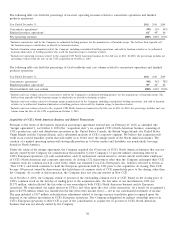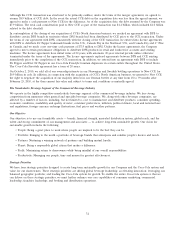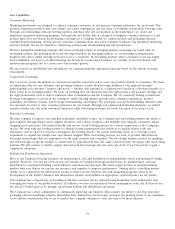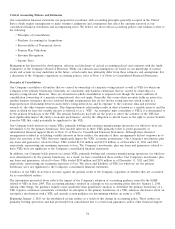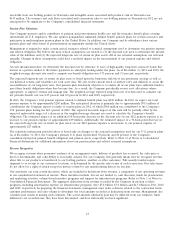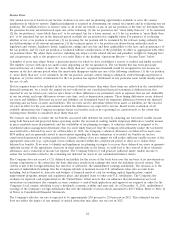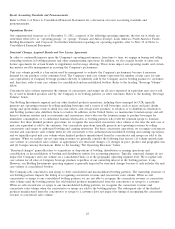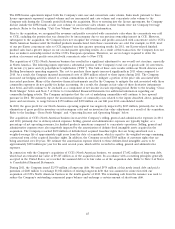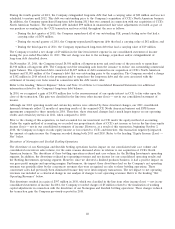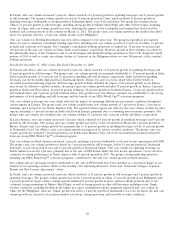Coca Cola 2011 Annual Report Download - page 41
Download and view the complete annual report
Please find page 41 of the 2011 Coca Cola annual report below. You can navigate through the pages in the report by either clicking on the pages listed below, or by using the keyword search tool below to find specific information within the annual report.When facts and circumstances indicate that the carrying value of definite-lived intangible assets may not be recoverable,
management assesses the recoverability of the carrying value by preparing estimates of sales volume and the resulting gross profit
and cash flows. These estimated future cash flows are consistent with those we use in our internal planning. If the sum of the
expected future cash flows (undiscounted and without interest charges) is less than the carrying amount of the asset (or asset
group), we recognize an impairment loss. The impairment loss recognized is the amount by which the carrying amount exceeds the
fair value. We use a variety of methodologies to determine the fair value of these assets, including discounted cash flow models,
which are consistent with the assumptions we believe hypothetical marketplace participants would use.
We test intangible assets determined to have indefinite useful lives, including trademarks, franchise rights and goodwill, for
impairment annually, or more frequently if events or circumstances indicate that assets might be impaired. Our Company
performs these annual impairment reviews as of the first day of our third fiscal quarter. We use a variety of methodologies in
conducting impairment assessments of indefinite-lived intangible assets, including, but not limited to, discounted cash flow models,
which are based on the assumptions we believe hypothetical marketplace participants would use. For indefinite-lived intangible
assets, other than goodwill, if the carrying amount exceeds the fair value, an impairment charge is recognized in an amount equal
to that excess.
We perform impairment tests of goodwill at our reporting unit level, which is one level below our operating segments. Our
operating segments are primarily based on geographic responsibility, which is consistent with the way management runs our
business. Our operating segments are subdivided into smaller geographic regions or territories that we sometimes refer to as
‘‘business units.’’ These business units are also our reporting units. The Bottling Investments operating segment includes all
Company-owned or consolidated bottling operations, regardless of geographic location, except for bottling operations managed by
CCR, which are included in our North America operating segment. Generally, each Company-owned or consolidated bottling
operation within our Bottling Investments operating segment is its own reporting unit. Goodwill is assigned to the reporting unit
or units that benefit from the synergies arising from each business combination.
The goodwill impairment test consists of a two-step process, if necessary. The first step is to compare the fair value of a reporting
unit to its carrying value, including goodwill. We typically use discounted cash flow models to determine the fair value of a
reporting unit. The assumptions used in these models are consistent with those we believe hypothetical marketplace participants
would use. If the fair value of the reporting unit is less than its carrying value, the second step of the impairment test must be
performed in order to determine the amount of impairment loss, if any. The second step compares the implied fair value of the
reporting unit’s goodwill with the carrying amount of that goodwill. If the carrying amount of the reporting unit’s goodwill exceeds
its implied fair value, an impairment charge is recognized in an amount equal to that excess. The loss recognized cannot exceed
the carrying amount of goodwill.
Intangible assets acquired in recent transactions are naturally more susceptible to impairment, primarily due to the fact that they
are recorded at fair value based on recent operating plans and macroeconomic conditions present at the time of acquisition.
Consequently, if operating results and/or macroeconomic conditions deteriorate shortly after an acquisition, it could result in the
impairment of the acquired assets. A deterioration of macroeconomic conditions may not only negatively impact the estimated
operating cash flows used in our cash flow models, but may also negatively impact other assumptions used in our analyses,
including, but not limited to, the estimated cost of capital and/or discount rates. Additionally, as discussed above, in accordance
with accounting principles generally accepted in the United States, we are required to ensure that assumptions used to determine
fair value in our analyses are consistent with the assumptions a hypothetical marketplace participant would use. As a result, the
cost of capital and/or discount rates used in our analyses may increase or decrease based on market conditions and trends,
regardless of whether our Company’s actual cost of capital has changed. Therefore, if the cost of capital and/or discount rates
change, our Company may recognize an impairment of an intangible asset in spite of realizing actual cash flows that are
approximately equal to, or greater than, our previously forecasted amounts.
As of our most recent annual impairment review, the Company had no significant impairments of its intangible assets,
individually or in the aggregate. In addition, as of December 31, 2011, we did not have any reporting units with a material
amount of goodwill for which it is reasonably likely that they will fail step one of a goodwill impairment test in the near term.
However, if macroeconomic conditions worsen, it is possible that we may experience significant impairments of some of our
intangible assets, which would require us to recognize impairment charges. Management will continue to monitor the fair value
of our intangible assets in future periods.
In 2010, the Company had no significant impairments of its intangible assets, individually or in the aggregate. We acquired
CCE’s North American business on October 2, 2010, which resulted in the Company recording $14,327 million of intangible
assets, including goodwill. Refer to Note 2 of Notes to Consolidated Financial Statements. The acquired intangible assets
included $5,850 million of bottler franchise rights, which consisted of $5,200 million of franchise rights with indefinite lives
and $650 million of franchise rights with definite lives. The franchise rights with indefinite lives represent franchise rights
that had previously provided CCE with exclusive and perpetual rights to manufacture and/or distribute certain beverages in
39



